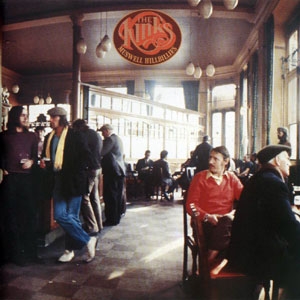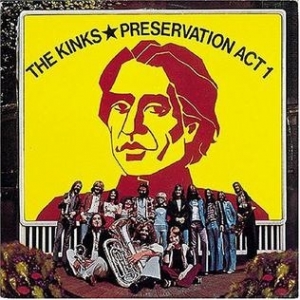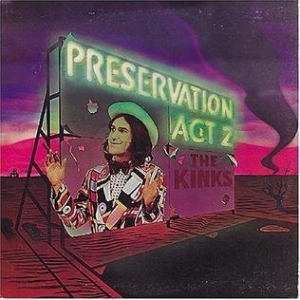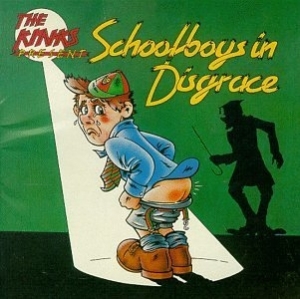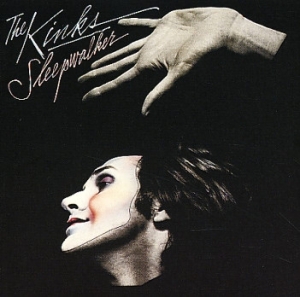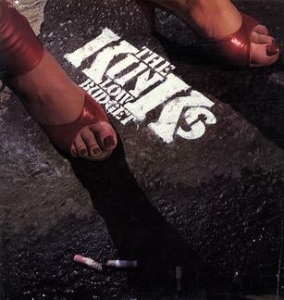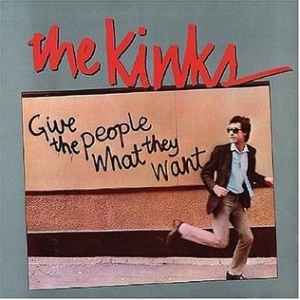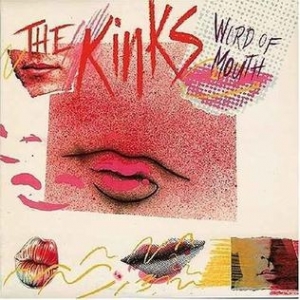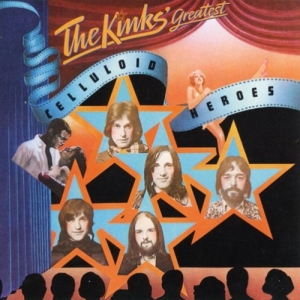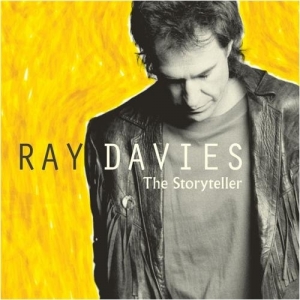Audio Engineer Mike Konopka Restoring The Kinks Archive
Everybody’s A Dreamer 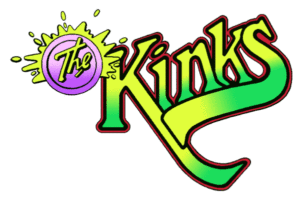
© Mike Konopka
Kinks/Vel Vel Deal Is Struck
I remember being in my office in Deerfield, Illinois after The Storyteller ’97 Fall Tour when one day I received a call from Sarah Lockwood at Konk Studios in London. It seemed that Raymond Douglas Davies (Ray Davies) had struck a deal with Vel Vel Records to license the Kinks back catalog of fifteen albums from the band’s RCA and Arista years.
While previously in London I had already completed remixes from the Kinks’ earliest work on the Castle label. But the RCA and Arista records were the real “meat and potatoes” of the Rock and Roll Hall of Famer’s catalog. And I was excited at the chance to have a small part of this chapter of rock’s history.
However, I realized that this “little chore” would be the most significant audio challenge thus far in my career. First of all, without bogging down in the morass of technical details, I’ll need to present an overview of what these challenges entailed and how they relate to this story.
Gathering The Kinks Analog Reels
There were over 250 master reels that, according to the terms of the agreement, were to be delivered to Vel Vel. And these masters were scattered all over the world. The Arista masters were stored in the company’s tape vaults in Los Angeles, Philadelphia, and New York City. The earlier RCA reels were in North London, mired away somewhere in the dungeons of Konk, the Kinks’ own recording studio.
Next, I knew that I would have to sift through these many reels to find the actual masters that the Kinks themselves had mixed for each album, not the outtakes, radio production copies, duplication or vinyl masters, or even safety copies. I would be at the mercy of RCA’s and Arista’s library staff as to the labeling accuracy of these master reels. Vel Vel wanted to re-release Kinks CDs. But I knew that an engineer years back had done similar work for Steely Dan. He had errantly used the wrong reels, which were mushy sounding copies. Nobody had caught it until these CDs were released and sadly, it stymied his engineering career. Ouch!
 The Reels Shed New Light
The Reels Shed New Light
Because I also knew that these old masters would be in deteriorating condition, many would need restoration baking to stabilize tape oxide shedding. I also knew that Ray’s mixing style involved splicing verse by chorus by verse, much like editing film. That meant all those old splices could break apart due to the aged splicing tape drying out. Just rewinding a reel carelessly could ruin a platinum selling album’s master that represented millions of dollars of sales! Ouch again!
Yet another issue I faced was that the master reel formats spanned over twenty years of recording technology. No single recording studio would have all these different tape machines and noise reduction schemes. And when RCA and Arista released these tapes to me they were legally “in limbo” until they were delivered to Vel Vel. Security of these million dollar masters was of the utmost concern. And on my head!
Audio Engineer Mike Konopka Restoring The Kinks Archive
The next day a Fed-ex box arrived from Miriam Gonzalez at Arista Records. It was filled with some 200 pages of information. Each page represented a Kinks master reel in Arista’s tape libraries. Some info was quite complete, while some pages were a bit sketchy, but it was a good starting point. I called Miriam and asked her to put out the APB on all Kinks masters nationwide. She agreed to gather the masters to their NYC office promptly.
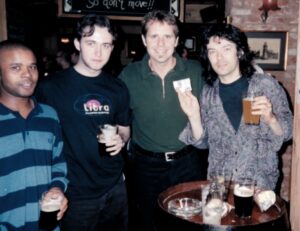
I also rang up my trusty “teaboys” (the Brit term for second engineer) Ryan and Albert at Konk and gave them the skinny on tracking down the RCA masters in the studio’s musty basement in Hornsey. Things were inching along at 1 & 7/8″ ips…
The Right Place To Un-Wind?
Timothy Powell, of Metro Mobile Recording, suggested that I call a mutual EARS (Chicago’s Engineering & Recording Society) friend, Fletcher, at Mercenary Audio in Boston. Fletcher is a famed audio geek and an absolute analog Luddite. He despised digital audio almost as much as he disliked the Grammy © Awards. So when he recommended a digital to analog converter to make great sounding DAT transfers, I listened carefully. And he really had my ear when he told me about The Toy Specialists.
One reason Chicago’s studio scene was considered paltry by New York, London, Nashville, and Los Angeles’ standards in those days, was the lack of equipment rental companies. In any of those other cites you would phone a “hire” outfit twenty-four hours a day and get any mic, any tape machine, any piece of outboard gear and have it delivered within thirty minutes. Sadly, in those days, Chicago clientele wouldn’t pay for hire gear, period. Today with the demise of major studios, rental firms like this are vanishing too.
The Transfermat
But back then in the 90’s, the Toy Specialists was just one of these rental companies in Manhattan. Fletcher informed me that they had just opened the “Transfermat” in the back of their warehouse, on the city’s upper West Side. A call to The Toy Specialists’ owner, Bill Tesar, confirmed that this was the place for me. They had all the different format machines in their rental pile. Right downstairs from Atlantic Records’ tape library, I could use Atlantic’s special oven to bake and stabilize shedding reels.
Also, Bill would provide me a teaboy and a tech person. And, because their rental operations ran twenty-four hours a day, someone was always there to watch the Kinks’ masters while they were “in limbo.” Plus, I would be the only one to have a key to the Transfermat.
Hi-Rez Saves The Kinks
I knew then in ’97, that DVD was just around the corner. DVD’s higher storage capacity can yield audio quality better than twice as good as a CD’s. I knew that if I was going to handle all these aging master tapes, I had better find the highest resolution digital format on the planet. Cutting nice sounding 16 bit DAT’s wouldn’t get it. But at that time 44.1k/16 bit digital audio was the norm. This was before today’s lo-fi MP3’s, iPods, and smartphones dominated the music delivery market.
So I tracked down (with Bill’s help) the people at Pacific Microsonics in Northern California. At that time, they had had an HDCD (high definition) system in place for a couple of years which made better sounding , 20 bit emulated CD’s. Their new HD-1 96k 24 bit analog to digital converters had just then been completed with an eye on DVD. They agreed to rush me one of the first beta units. By luck, my timing was perfect and The Kinks would be the first recording artists to utilize this new technology for an entire catalog. As a result, we not only would have a better sounding CD with current technology, but these 88.2k/ 24 bit masters would be able to shake hands with future recording formats for many years to come.
Audio Engineer Mike Konopka Restoring The Kinks Archive
And for the massive amount of data storage, I chose a Genex GX-8000 removable optical disc recorder which would yield a shelf life for these masters of over 100 years! I don’t know if Ray ever fully realized this contribution I had made to The Kinks catalog and masters longevity.

Thankfully Billboard Magazine, and Pro Sound News did, as they ran features about the new technology and my engineering approach. Famed mastering guru Bob Ludwig would handle the final CD mastering downstream from my work.
Via fax, (remember fax?) I brought Phil Kurnit, the Vice President at Vel Vel, and Deke Arlin, Ray’s manager at that time, up to speed on all of this. I nailed down my day rate plus expenses and per diam, then grabbed the next plane for La Guardia.
I’ll Take Manhattan
I flew in on December 9th, 1997. It was really balmy and humid there. I recall sharing a cab with two other people, which was the common practice then. They even had a matchmaker dude at the airport cab stand to pair co-riders with taxicabs. We all sat quietly in the rumbling taxi as we made the trip onto the big island. I sat in the front seat sweating in my biker jacket which I had bought in The East Village the year before.
I can still picture looping around that massive cemetery in Queens. It was absolutely crammed with towering headstones, fanning out at radical angles like they had tried to fit too many markers in one place. Pre 911, there was an eerie parallel of this cemetery in the foreground, and Manhattan’s jutting skyscrapers in the background. Smokestack factories surrounded the cemetery on three sides. I felt small and insignificant. We motored on.
I was the first passenger out of the cab, thankfully. Vel Vel put me up at the Park Central Hotel on 7th Avenue at 59th.  It was kitty corner from Carnegie Hall and close to the southernmost boundary of Central Park. It was also only a fifteen minute walk to The Toy Specialists. The Park Central featured a great location but was a real dump. Throngs of tourists, Japanese businessmen, and holiday funsters formed long lines at the check-in counter. Thirty minutes later I finally made it up to the desk. Vel Vel hadn’t called their Amex number in yet, so I had to tender my Visa card for the $375 a night room. Yikes! They finally gave me a key to a “No Smoking” room on the 11th floor.
It was kitty corner from Carnegie Hall and close to the southernmost boundary of Central Park. It was also only a fifteen minute walk to The Toy Specialists. The Park Central featured a great location but was a real dump. Throngs of tourists, Japanese businessmen, and holiday funsters formed long lines at the check-in counter. Thirty minutes later I finally made it up to the desk. Vel Vel hadn’t called their Amex number in yet, so I had to tender my Visa card for the $375 a night room. Yikes! They finally gave me a key to a “No Smoking” room on the 11th floor.
No Breathing Apparatus
The hotel’s elevator was the slowest, ricketiest thing ever. As the doors opened at different floors, strange noises and smells filled the car. I got off on eleven and wheeled my bag toward my room. As soon as I opened the door, I knew there was no way I could ever stay in there. It was about the size of a closet, smelled of every foul human, animal, and vegetable odor, and sported matted down orange shag carpet and a stained bedspread. And me without my gas mask!
I stormed back downstairs, (if you can storm in a rickety, slow moving elevator..) waited another thirty minutes in line, and pled in robust tones for another room. They gave one up in sympathy. Either that or they didn’t want the other waiting guests to hear my sad tales of woe!
This next room was on the third floor. I rode up again and strode down the hall with great trepidation. But this room was awesome! A nice clean suite with a 27″ TV, and a view of Carnegie Hall. Things were really looking up. I fell asleep to the sounds of traffic bustling just below.
Gettin’ Around Ed Sullivan
I had set ten hour work days at the Transfermat, 10:00 am to 8:00 pm every day. Therefore, I left my suite and ventured out onto the street around 8:45 am that following morning. I strolled south along 7th Avenue, past the famous Carnegie Deli (as featured in Woody Allen’s Broadway Danny Rose), and finally turned right on 54th street. The infamous Studio 54, where Andy Warhol and The Velvet Underground shaped the trendy sixties counter culture, now stood sadly shuttered.
I crossed Broadway and spotted the old Ed Sullivan Theater just to the south. The Beatles changed the world there one night. I know this because I, as a second grader, witnessed it on the old black and white Crosley TV in Golf, Illinois. And as I have said before, that second grader made a decision that a full grown man is still living with! At that time, the theater hosted Late Night with David Letterman. Currently, my old Second City pal, Steve Colbert is in there.
I found this really awesome deli / bagel bakery on that same corner. And each day I went there before work for my breakfast. As I enjoyed my tasty NY bagel and drank freshly-squeezed juices, I thought about all the bands I had seen on Ed Sullivan and how they’d shaped my musical life. Along with the Beatles were The Stones, The Who, The Association, Kenny Rodgers & First Edition, Herman’s Hermits, and of course the Doors. On Sunday nights at 6:30, my whole family always watched The Ed Sullivan Show together. Always.
Doors Past & Present
That’s why I dreaded whenever the Doors performed. Not that I didn’t dig them, far from it! But when Morrison went into his pelvic thrusting antics, my parents got these horrified looks on their faces and lectured me, “You are NOT getting an electric guitar young man!!” Ironically, two weeks after my mom passed away, I won my first electric guitar in a contest that a local radio station held. A baby blue Kalamazoo for a thirteen year old. “You know that I would be untrue…”
Anyway, after breakfast I ventured on westward toward the Toy Specialists, past cab repair garages, Asian restaurant supply houses, parking lots, and pushcart vendors.

Past Sony Studios, and the world famous Hit Factory where Bon Jovi cut most of their work. The studio’s facade had these international flags all lined up like some low-rent version of the UN. The rumor then was that this studio was owned by mob boss John Gotti. Each morning I walked by, string players were gathering outside the marble faced studio with their violins and viola cases. Either for a big film scoring date, or to help perpetuate the mob myth. Rat-a-tat-tat-tat!
Audio Engineer Mike Konopka Restoring The Kinks Archive
Eventually I came upon 619 W. 54th, a rather run-down looking warehouse building with scratched up Plexiglas doors. I pushed the bell and was buzzed in. Rita Tesar, Bill’s wife warmly greeted me. They led me through the rental warehouse to the Transfermat in the back of the building. Everything was set up as I had requested. Everybody there treated me like I was a star! An assortment of exotic fruits, pastries, and beverages was on hand. I had my own personal teaboy, Larry Greenbaum. And everyone who worked there came in to greet me. I was so relieved to have these new friends. New Yorkers can be so outgoing!
Kinks Big Fish Stories
Rita told me that the Arista tapes would be arriving by truck shortly. But she was worried about something. Years before, she worked for a large rock radio station in Manhattan. Back then, The Kinks did an “on the air” studio jam from a local studio on that same radio station.
Apparently, there was a disagreement about the subsequent rights to the masters of this broadcast. In anger (a put-on display from what I knew) Ray supposedly had picked up a wine bottle and thrown it through an aquarium in the studio’s control room. It shattered it to pieces spewing fish, water, and gravel everywhere! Over the previous months, I had heard lots of these sad tales. Yet I was determined to stay focused on the job at hand and was unconcerned about this particular horror story.
But Rita was terrified of Ray. And from the flurry of calls from Sarah in London, Rita knew he would be arriving soon to inspect the premises. I calmed her down by informing her of a simple fact: Ray always judged a new venue, radio station, or studio, by how long it took him to get a “proper” cup of tea after he arrived. I don’t ever recall Ray getting a tea faster than that day. Before Ray’s English butt even hit the chair the cup of Darjeeling Orange was in his hands. Rita “swagged” us a pile of white Polo shirts too.
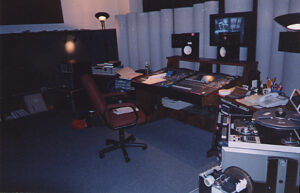
Moneypenny & The Kinks Masters
Soon the masters made it over from Arista and after looking them over, Ray quickly approved of the proceedings and returned to his townhouse on the upper West Side.
Even though he was out of my hair, my problems were just beginning. Hundreds of master tapes filled every square inch of floor space of the Transfermat. Many tapes seemed to be missing. Worse yet, I was given the job of pairing “bonus tracks” or unreleased outtakes and B-sides with the appropriate album. As much of a Kinks authority as I was, I was way over my head. I did what the real James Bond/007 would have done. I called Moneypenny.
Moneypenny was the nickname Ray had dubbed Jayne Grodd. Jayne and I had met about a year earlier in Toronto and became fast friends due to our mutual experiences and frustrations in the music biz. She was a super fan but not a fanatic. And boy she knew everything, I mean everything about the Kinks. I had been in contact with her before I came to New York, and I knew she would be the only one who could help me. And help me she did.
Jayne Digs In
Jayne’s a tall, dark, angular woman. She dressed always in black, has jet black hair, and porcelain white skin. She used to pull down big bucks as vice president of EMI records until they closed down their US operations. Yet when she arrived at the Transfermat, she buckled down like a New Jersey longshoreman. I was flabbergasted at how hard she worked to help me wade through the boxes and boxes of dusty tapes.
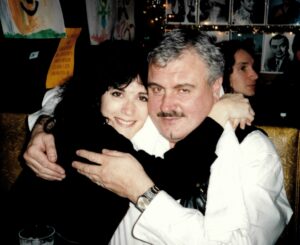
Maybe she enjoyed some sort of euphoria handling all those original Kinks masters. But by 2:00 pm that afternoon everything was sorted and I had located enough actual masters to start transferring to Hi-Rez. She had also matched rare “bonus track” cuts to the appropriate albums too. I was also able to figure out which tapes needed baking as well. And I determined that sixty Arista reels were still missing. I called Miriam and told them to search their libraries with a finer toothed comb.
By 6:00 pm Ray had returned. I was busy transferring the Sleepwalker album and its bonus cuts. Jayne had only ever spent minimal amounts of time with him, but he had been her hero for many years. She knew what a handful he could be, but was still drawn to him. Ray was delighted at what she had done to help us, so he took her for dinner. I stayed behind, baking tapes, and finished dubbing Sleepwalker before sleep-walking back to my hotel exhausted.
Ray Davies Is A Nice Guy Actually

Later, I learned that Ray had taken Jayne to his meeting with the powerful Walter Yetnikoff, then president of Vel Vel. Brooklyn-born Yetnikoff, former CEO of Sony Music, was the man who signed Bruce Springsteen and Boston. He was well profiled in the book Hit Men for his notorious record business practices. Ray asked Walter to hire Jayne. They gave it some thought but I think Jayne wanted out of the record business at that point in her career. Record business? What record business?
This just showed how you could never figure Ray out. Just when you thought he was the biggest pain ever, he would do something really nice for someone. He genuinely respected Jayne. She helped me the entire time I was in New York working, calling to check in, answering queries about the catalog, and stopping in once in a while to lend an ear. She never got anything for it. I think maybe I took her for Italian one night. Early in 1998, I considered trying to get her a job at Konk where she really could have done some good.
But I actually did fight to get her a “thanks” on all fifteen of those Kinks CDs. And her name’s now on them forever. A credit on her favorite band’s best work. I felt pretty damn good about that actually.
I’m A Misfit Too
Back in the Transfermat the next morning I had the master of the Misfits album on the tape machine. The title cut was the first song up. I hit the play button on the trusty Ampex ATR-100:
You’ve been sleepin’ in a field, but you look well rested,
You set out to outrage, but you can’t get arrested,
You claim your energy’s new, but it looks well tested,
You’re lost in a crowd, yet you go your own way….
You’re a Misfit, afraid of yourself so you run away and hide,
You’ve been a Misfit all your life, why don’t you join the crowd and come inside?
I remember wearing out the grooves on that album back in 1979 after my first girlfriend dumped me. We were together for six years. She had moved to Madison, Wisconsin for a fashion merchandising gig. One night I called her and she told me, “I have to live my own life.” She was in love with her straight-laced store manager. Married him too. A year before our breakup, we went to see the Kinks together at the Uptown in Chicago and they were terrific. Ray was brilliant. My first Kinks show. Somehow a kid from Golf, Illinois fit in with the other outcast Kinks fans that evening.
Now my job is to archive the very master tape of the album that pulled me through 1979.
Low Budget Blur
Later that day I archived Low Budget with “Wish I could Fly Like Superman.” I also started transferring One For The Road which was a double live release. Only got half of it done that day. I wanted to meet my niece Laurie for Thai food that night so I split promptly at 8:00 pm.
The rest of the workdays blur together mostly. I dubbed Give The People What They Want, and Word of Mouth. I do remember having to stay an extra couple of days because the RCA masters were stuck in customs during the weekend. Something with the UK paperwork was amiss so U.S. Customs held them awaiting proper documentation. But the sixty missing Arista masters had shown up at least.
Audio Engineer Mike Konopka Restoring The Kinks Archive
Ray-Foo Yung
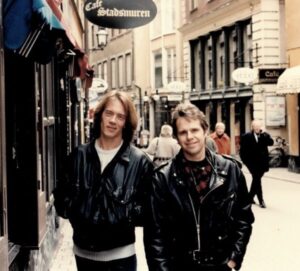
I also remember an evening that Kirk Madsen (Ray’s stage manager) and his friend came down to meet me. They picked me up after work at the Transfermat. I offered to treat them for dinner. Kirk said he knew of a great Chinese joint that was right next door to Irving Plaza, the rock club that he used to manage. But before we left the Toy Specialists, Ray rang up and decided to meet us for dinner too.
The three of us met up with Icon (Ray’s crew’s nickname for him) at this little restaurant in Midtown. And as Kirk promised, the food was incredible and all meals included free wine as well. This place was so cheap the total for all four of us was only sixty-two bucks! Such a deal in New York City!
So we ambled next door to the club to catch Luna’s set. Everybody at Irving Plaza knew Kirk and they rolled out the red carpet for us. As mentioned, Kirk at one time ran that club. Free drinks, VIP seating, and friendly smiles all around towards Mr. Davies. Ray wasn’t impressed with Luna so he gave us his free drink coupons and left.
Celluloid Heroes Un-spools
The next morning the RCA masters finally arrived. Muswell Hillbillies (featuring “20th Century Man”), Everybody’s In Showbiz, Preservation Act I, Preservation Act II (double album), Soap Opera, and Schoolboys In Disgrace. My teaboys in London had done their jobs admirably. It was a huge relief to me as all the tapes were correct and complete.
All the transfers went fine too until I spooled up Everybody’s In Showbiz. You see that’s the record that contains “Celluloid Heroes.” In my opinion it’s Ray Davies finest work. When I had lived in Dave Davies’ house in Highgate, and read Dave’s book Kink, he wrote about how cruel, uncaring, and self absorbed Ray could be. Dave wrote that he hated Ray and blamed him for all the shortcomings in his own life. Yet he also said that Ray had perceptions and insights of the human condition that only someone capable of great love and understanding could ever obtain. Dave said that Ray taught us all about ourselves.
Beyond Human Scale

“Celluloid Heroes” is like Ray’s Fallingwater, and like Frank Lloyd Wright’s essential and beautiful masterpiece, the 1972 song elevates and humbles your spirit simultaneously. And its keen observations of the American Dream could only be made by an outsider Brit misfit like Ray. His lyrics speak to Hollywood’s classic stars and their sometimes fulfilled and more often shattered dreams. But between the lines he’s speaking to anyone with the courage to dream beyond their worldly limitations. And as Wright’s and Davies’ creations towered beyond their own human scale, their daily lives suffered from like demons as well.
In the 36 months I worked for Ray I only heard him play that song once. And that was when we played at UCLA in Los Angeles. Now, in a back room warehouse on the upper West Side, the master reels rotated like second hands on some huge clock:
Everybody’s a dreamer, and everybody’s a star,
And everybody’s in movies, it doesn’t matter who you are,
There are stars in every city, in every house, and on every street,
And as you walk down Hollywood Boulevard,
Their names are written in concrete,
You can see all the stars as you walk down Hollywood Boulevard,
Some that you recognize, some that you’ve hardly even heard of,
People who worked, and suffered, and struggled for fame,
Some who succeeded, and some who suffered in vain..
De-compression
That following Sunday was my first day off. I decided to finish up my Christmas shopping on 5th Avenue. So I walked over from my hotel on 7th and turned toward downtown on the world’s greatest shopping avenue.
Even though I was making money, I knew I wouldn’t get paid for a month and I had to not only budget for my trip back to Chicago, but also for my trip to England to finish The Storyteller album that following January 5th. So the shopping trip was sparse.
That evening my niece Laurie asked me to meet my now late cousin Marilyn and her daughter Alexis at their high-rise apartment in the Village. I took the subway down and walked about eleven blocks on that chilly evening. They were having a Christmas party with about a dozen guests. I sat and watched people I didn’t know open gifts. Later after the guests left, Marilyn showed me pictures of my mother while she was pregnant with me.
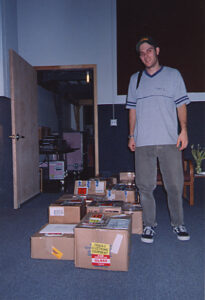
“Cabbie, Vel Vel, Then Home!!”
Monday morning Larry and I boxed up the masters, and delivered them to Vel Vel in a panel van. I spent three hours going over the manufacturing details with their production staff. I had my big suitcase as my return flight was that afternoon. Several cabbies pulled over in front of Vel Vel, took one look at my suitcase, and then rudely drove off without me. Finally a big hearted driver agreed to take me to La Guardia. Delighted to be going home, I was proud.
And why not? I had accomplished the technically impossible and I was on top of the world. Anything I set my sights on had became reality. I felt cocky and in-control.
Epilogue
But to this day I still hear Ray’s stern warning in the last verse of “Celluloid Heroes.” I’ve honed my professional listening skills for over forty years, yet I always remember his simple truth:
Everybody’s a dreamer, and everybody’s a star,
And everybody’s in showbiz, it doesn’t matter who you are,
But those who are successful, be always on your guard,
You see success walks hand and hand with failure,
On Hollywood Boulevard.
I wish my life was a non-stop Hollywood picture show,
A fantasy world of celluloid villains and heroes,
Because celluloid heroes never feel any pain,
And celluloid heroes never really die.
Mike Konopka’s Kinks credits include:
Audio Engineer Mike Konopka Restoring The Kinks Archive
Worried About Your Analog Tapes ?
Get Your Free Restoration Quote Now!

 The Reels Shed New Light
The Reels Shed New Light